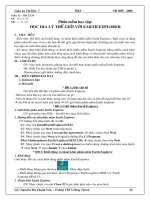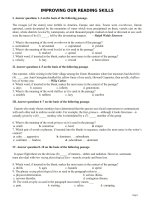- Trang chủ >>
- THPT Quốc Gia >>
- Hóa
Our magnetic earth
Bạn đang xem bản rút gọn của tài liệu. Xem và tải ngay bản đầy đủ của tài liệu tại đây (5.06 MB, 14 trang )
Physical Sciences
Genre
Nonfiction
Comprehension Skill
Main Idea and Details •
•
•
•
Text Features
Captions
Diagrams
Maps
Glossary
Science Content
Magnetism
Scott Foresman Science 4.2
ISBN 0-328-23545-8
ì<(sk$m)=cdfefc< +^-Ä-U-Ä-U
Vocabulary
Extended Vocabulary
electromagnet
generator
magnetic field
magnetic poles
magnetism
aurora
dynamo theory
ionosphere
magnetometer
magnetosphere
Main Field
solar wind
Van Allen belts
Picture Credits
Illustrations
22 Adam Benton.
Photographs
Every effort has been made to secure permission and provide appropriate credit for photographic material. The
publisher deeply regrets any omission and pledges to correct errors called to its attention in subsequent editions.
Unless otherwise acknowledged, all photographs are the copyright of Dorling Kindersley, a division of Pearson.
2 Erich Schrempp /Photo Researchers, Inc.; 6 NASA; 8 ©DK Images; 9 Photo Researchers, Inc.; 11 ©Kennan Ward/Corbis;
16 Geoff Lane/CSIRO/Photo Researchers, Inc.; 19 Luciano Corbella/DK Images.
ISBN: 0-328-23545-8
Copyright © Pearson Education, Inc. All Rights Reserved. Printed in the United States of America.
This publication is protected by Copyright, and permission should be obtained from the publisher prior to any
prohibited reproduction, storage in a retrieval system, or transmission in any form by any means, electronic,
mechanical, photocopying, recording, or likewise. For information regarding permission(s), write to
Permissions Department, Scott Foresman, 1900 East Lake Avenue, Glenview, Illinois 60025.
1 2 3 4 5 6 7 8 9 10 V010 13 12 11 10 09 08 07 06
What You Already Know
Magnetism is a force. It acts on a moving electric charge
and nearby magnetic materials. A magnetic field is the space
around a magnet in which magnetic forces act. A magnet’s
strength and shape determine its magnetic field. A magnet’s
poles are where its magnetic force is greatest.
Magnetic fields are invisible. They are made by electric
currents. You can “see” magnetic fields with iron filings.
Every magnet has two magnetic poles. One pole is
called the north pole. The other is called the south
pole. A south magnetic pole will align with
the north pole of a magnetic field. A
north magnetic pole will align with the
south pole of a magnetic field. Like
magnetic poles repel each other.
Unlike magnetic poles attract
each other.
An electromagnet is a coil of wire wrapped around an
iron bar, or something else that can be given a magnetic field.
As the current passes through the wire, it creates a magnetic
field around the bar. A generator is a machine made from
wires coiled around powerful magnets. Generators turn
motion into electrical energy.
The world of magnets and magnetism is filled with
fascinating stuff! You have learned about the magnetism of
simple magnets and compasses. But magnetism also exists
deep within Earth and in Earth’s atmosphere. Keep reading to
find out more about this magnetism.
The iron filings scattered
around this horseshoe
magnet have aligned with
its magnetic field.
2
3
Geomagnetism
Earth is made up of several layers. The top layer is a solid
crust. The continents and ocean floors sit on the top of this
crust. Below the solid crust is a semisolid mantle. Then comes
an outer core. Scientists think it is made up of hot liquid iron,
also called molten iron. Finally, there is a solid inner core.
Scientists think it is also made up of iron.
Most of Earth’s magnetism comes from its outer core.
Scientists think the outer core is about 3.5 billion years old.
Scientists think Earth itself is 4.5 billion years old. So
magnetism began early in Earth’s history.
Solid Crust
Earth is like a giant magnetized
sphere. The magnetic field
surrounding Earth is called the
Semisolid Mantle
geomagnetic field. The word
“geomagnetic” comes from the
Greek geo, meaning “Earth,”
and magnetic, meaning “the
force of magnetism.”
The geomagnetic field is huge. It is created by electric
currents moving deep below and high above Earth’s surface.
Scientists still have a lot to learn about the geomagnetic
field. But the field can be hard to study. For one thing,
scientists will never be able to travel into Earth’s core. It is too
hot and has too much pressure for people to survive there.
But scientists have learned a lot about geomagnetism by
looking at and studying things from Earth’s surface.
For example, scientists have observed that the
geomagnetic field is constantly changing. These changes are
probably caused by changes within Earth’s crust and mantle.
Scientists cannot go into the crust and mantle. But their
observations make sense based on ideas about the crust |
and mantle.
This diagram shows the lines of force that
make up Earth’s geomagnetic field.
Liquid Iron Outer Core
Solid Iron Inner Core
Earth
4
5
The Main Field and Dynamo Theory
The Main Field makes up about nine-tenths of the
geomagnetic field. It is made by Earth’s outer core. The outer
core is made up mostly of iron. This iron is not like the iron
on Earth’s surface. The heat of the iron in Earth’s outer core
stops the iron in the core from being magnetic.
This leads to a mystery. The outer core’s iron is too
hot to be magnetic. So how can the outer core create
geomagnetism? And how has geomagnetism been able to last
for millions of years without weakening? Scientists have come
up with a theory called “dynamo theory” in an attempt to
solve this mystery.
The red areas of this model show where
Earth’s crust is most magnetized. The blue
areas show where it is least magnetized.
A handle turns a
copper disc.
The copper disc
spins in the
magnetic field.
electromagnet
Dynamo theory was named for the dynamo, which the
British scientist Michael Faraday invented in 1831. The
parts that make up a simple dynamo are labeled.
Here is how dynamo theory works: heat currents cause
the molten iron in Earth’s outer core to flow. The flow is kept
moving by the Earth’s spinning. Molten iron is very different
from solid iron. But it still conducts electricity.
When molten iron flows across a weak magnetic field, it
makes an electric current. The electric current makes a new
magnetic field. The new magnetic field combines with the old
magnetic field. Together they form a stronger magnetic field.
This is the Main Field.
Dynamo theory explains why the Main Field has lasted
and stayed at about the same strength. It has lasted because
the outer core’s molten iron has kept flowing. It has stayed at
the same strength because two magnetic fields are constantly
mixing to create it.
6
7
Sources of the Geomagnetic Field
Earth’s geomagnetic field comes from several sources.
Electric currents flowing through space make up part of it.
So do electric currents flowing through Earth’s crust and
oceans. Magnetic rocks on Earth’s surface contribute to
geomagnetism. So does the ionosphere.
The ionosphere is a part of the upper atmosphere. The
flow of electricity in the ionosphere is strong enough to
influence Earth’s magnetic field. This flow of electricity
is caused mainly by radiation from the Sun hitting the
atmosphere. The electrical current made by the Sun’s
radiation creates magnetic fields. These fields contribute to
the overall geomagnetic field. They also cause changes to the
geomagnetic field.
These metal nails were attracted to
this rock’s magnetic field. Magnetic
rocks contribute to geomagnetism.
8
Sun
This illustration, which is not to scale,
shows Earth’s magnetosphere being hit by
the Sun’s solar winds.
The part of the geomagnetic field that reaches into space
is called the magnetosphere. The magnetosphere protects
Earth from the Sun’s solar winds. These winds carry an
electric charge. Their electric charge makes them magnetic.
Solar winds from the Sun travel millions of miles from the
Sun toward Earth. When they hit Earth’s magnetic field, the
side of the magnetosphere facing the Sun is pushed inward.
The side facing away from the Sun streams outward. This
makes the magnetosphere quite lopsided.
The magnetosphere is important to life on Earth. Without
it, solar winds would hit our planet. This could result in a loss
of Earth’s water and atmosphere. Scientists think such an
event may have happened on Mars.
9
Auroras and Van Allen Belts
Even with the magnetosphere, Earth is still affected by
solar wind. If enough solar wind gets through, it can cause
auroras. Auroras are colorful lights in the upper atmosphere.
Usually auroras are seen only near the geographic poles.
However, in periods of heavy solar winds, they can be seen
over much wider areas.
For years, people have enjoyed looking at auroras. But
the auroras actually warn us of the danger of solar radiation.
The solar wind that creates auroras contains radiation. When
that radiation hits the magnetosphere, it becomes trapped.
In 1958, James Van Allen proved that this trapped radiation
existed. Since then it has been called the Van Allen belts. The
radiation can damage satellites and spacecraft. If astronauts
spend too much time in space, it can hurt them.
It was once claimed that the Van Allen belts were a result
of nuclear testing! Scientists now know that nuclear testing
did not make them. Instead, natural forces created the Van
Allen belts.
Auroras such as the one shown here
are created when solar winds hit
Earth’s atmosphere.
10
11
The Geomagnetic Poles
In some ways, Earth’s magnetism is like that of a bar
magnet. Like a bar magnet, Earth has two magnetic poles.
These poles occur where the magnetic lines of force bunch
together. But unlike a bar magnet, the location of these
poles is continually changing. This is because Earth’s overall
magnetic field is continually changing.
The magnetic north pole is located in the Canadian
Arctic. The magnetic south pole is located in the Antarctic
Ocean, south of Australia.
There are important differences
between the magnetic poles and the
geographic poles. For example,
Magnetic North Pole
the geographic North Pole is
located directly opposite
from the geographic
North Pole
South Pole. The two
geomagnetic poles are
not directly opposite
from each other.
South Pole
This diagram illustrates the
locations of the geographic
poles compared to the
magnetic poles.
12
Magnetic South Pole
As this map demonstrates,
the north magnetic pole has
drifted steadily northwest
over the past century.
Earth’s magnetic poles can move as much as 80 kilometers
in a day. They move so fast that scientists avoid talking about
where they are at any one moment. Instead scientists talk
about the magnetic poles’ average position.
The Geological Survey of Canada (GSC) keeps track of
the north magnetic pole’s drift. Their records show that the
pole has moved over 1,100 kilometers in the past century.
The pole does not move at the same constant rate. From
1831 to 1904, the pole barely moved. But starting around
1970, the pole began moving quite rapidly. At the time, the
pole was moving at about 10 kilometers a year. The latest
GSC studies show that the north magnetic pole is moving
northwest at about 40 kilometers a year.
13
Compasses and the Magnetic Poles
The magnetic poles are constantly moving. So how can
people rely on compasses? They can rely on them because
of Earth’s magnetic lines of force. These lines run north and
south between the magnetic poles. Compass needles line up
with the lines of force to point north and south. They tell a
compass user where north and south are.
However, compasses become unreliable when they are
used near the magnetic poles. Why? Compass needles line
up with magnetic lines of force. But the lines of force bunch
up near the magnetic poles. They are no longer straight, like
normal lines. This makes compass needles swing away from
pointing north and south. Fortunately, scientists have figured
out the zones around the magnetic poles in which compasses
become unreliable.
14
Which Way Is North?
Most travelers want to know where they are
compared to the geographic poles. But compass
needles point toward the magnetic poles
instead. Fortunately, there is math we can use
to relate the magnetic poles to the geographic
poles. The numbers used to do the math change
depending on your location and the position of
the magnetic poles.
A map can show both the
geographic poles and magnetic
poles. A compass points to the
magnetic poles.
15
Scientists and
Magnetism
Scientists think that Earth’s magnetic field has always
been changing. This makes it impossible to predict accurately
what the field will look like, or how it will act, in the future.
However, there are many things about Earth’s magnetic
field that scientists can measure. For example, scientists can
measure the direction of the geomagnetic field at any one
point. Scientists can also measure its strength.
Such measurements allows scientists to “see” into Earth
and learn about rocks buried deep below the surface. The
measurements of Earth’s magnetic field can describe buried
rock formations, including the faults that create earthquakes.
The measurements
also help scientists
make predictions about
changes to Earth’s
surface.
This scientist is researching
magnetic reversals. You will
read about magnetic reversals
later in the book.
16
Here you see an oceanographer with a map of the
ocean floor. The ocean floor shows evidence of
Earth’s past magnetic field.
Scientists who measure Earth’s magnetic fields are called
physicists. These physicists work with oceanographers,
geologists, and seismologists. Oceanographers study the
oceans. Geologists study soil and rocks. Seismologists study
Earth’s crust. Seismologists and geologists watch for any
relationship between Earth’s shifting geomagnetic field and
increased earthquake activity. So far, no link has been proven.
The electrical charge carried in the atmosphere and
oceans affects Earth’s magnetism. So meteorologists, who
study climate and weather, also study geomagnetism.
People who work with devices that send electronic signals
understand how changes in electromagnetic fields can affect
electronic communications. They can also play an important
role in studying geomagnetism.
17
Measuring and Monitoring
Magnetism
Magnetometers measure the strength of a magnetic field.
Magnetic observatories use ground-based magnetometers to
measure the strength of Earth’s magnetic field. They also note
any changes in the field’s location.
There are approximately 440 magnetic observatories
operating worldwide. About 100 of them have been collecting
records for 50 years. Ground-based magnetometers help
scientists study geomagnetism in several ways. These
instruments collect minute-by-minute information about the
location, range, and stability of the geomagnetic field.
These scientists work at the magnetic observatory
shown below. The observatory is in Fairbanks, Alaska.
Scientists study magnetism with satellite magnetometers
as well as ground-based magnetometers. Galileo is one kind
of satellite magnetometer. It orbits Earth collecting data. The
data are later used for geomagnetism studies.
There are reasons for and against using each type of
magnetometer. Ground-based magnetometers are much less
expensive. They are easier to set up and control. They also
give us many different sets of data, all at the same time, about
different parts of Earth’s magnetic fields.
Satellite magnetometers have one big advantage: they
cover a much wider area. Many ground-based magnetometers
are needed to cover the same area that just one satellite
magnetometer can study.
The geomagnetic field measured by satellite
magnetometers is somewhat different from the field
measured by ground-based ones. So scientists combine
measurements from both types of magnetometers
to better understand Earth’s
magnetic field.
The unmanned Galileo space probe
(right) can operate as a satellite
magnetometer.
18
19
Heading for a Reverse?
Some scientists think Earth’s magnetic field is getting
ready to reverse. Studies of the rocks on the ocean floor show
that Earth’s magnetic field has strengthened, weakened, and
reversed itself throughout Earth’s history.
Even if Earth’s magnetic field is beginning to reverse,
it would still take several thousand years to complete the
process. During a reversal, Earth’s magnetic field would be
weaker than it is now. This weaker magnetic field would also
have many magnetic poles. The last time the magnetic field
reversed was between about 750,000 and 780,000 years ago.
If a magnetic reversal were to occur right now, radio
communications might break down. Although compasses
would still work, their needles would point south.
Below are Earth’s magnetic
poles today, prior to a magnetic
reversal.
20
Below are Earth’s magnetic poles
after a magnetic reversal. The
poles have reversed themselves.
The magnetite in this sea turtle’s brain might help it migrate.
Animals might also have problems during a magnetic
reversal. Many animals seem to use Earth’s magnetic fields
as a guide. Sea turtles, for example, are able to return and lay
their eggs on the same beach where they were born. Scientists
think that magnetite, a mineral found in an animal’s brain,
may have something to do with this ability. Animals could
have problems migrating if the magnetic field were to reverse.
However, some scientists think that animals would be
able to adjust to a change in the magnetic field. They have
performed experiments that show animals can learn to use
weaker magnetic fields similar to those that Earth might have
during a reversal. Also, there is no evidence that animals have
become extinct because of a reversal.
21
New Discoveries
and Other Planets
Scientists are continually learning more about the Earth
through their observations. In 2005, scientists announced
that Earth’s solid inner core is probably spinning faster than
the rest of the planet. They learned this by studying the way
earthquakes traveled through the center of Earth.
What does this have to do with magnetism? Scientists
believe that the faster spin of the inner core is a result of the
magnetism generated in the center of the planet. They think
the core’s spinning might help support dynamo theory and
further explain how the Main Field is formed. They also think
the rate of the inner core’s spin depends on
variations in Earth’s magnetic field.
Space probes have provided scientists with data that
seem to show that Jupiter, Saturn, Uranus, and Neptune are
magnetized. In fact, these planets have magnetic fields that
are much stronger than Earth’s. Mars and Venus show little
magnetic activity. This might be because there is not enough
pressure in their cores to produce magnetic fields.
We have now finished our tour of Earth’s magnetism.
Who would have thought there was so much going on with
magnetism on our planet? And as it turns out, there’s a lot of
magnetism on other planets! One thing is for sure: scientists
will continue to study magnetism on Earth, and in the
universe beyond, until they’ve unlocked all of its mysteries.
This cutaway illustration of
Earth shows the direction of the
solid inner core’s spin.
Scientists have discovered that the magnetic
fields of Saturn (left) and Jupiter (right) are
stronger than Earth’s.
22
23
What did you learn?
Glossary
1. For about how long has Earth’s magnetic field existed?
aurora
colorful lights caused by solar wind
hitting the upper atmosphere
dynamo theory
the theory that describes how Earth’s
magnetic field is generated
ionosphere
the part of the upper atmosphere
where electromagnetic currents flow
magnetometer
an instrument for measuring the
strength of a magnetic field
magnetosphere
the space around Earth into which the
geomagnetic field extends
Main Field
the part of the geomagnetic field that
originates in Earth’s outer core
solar wind
electrically charged matter released
from the Sun
Van Allen belts
bands of harmful solar radiation
trapped by Earth’s magnetosphere
24
2. How does dynamo theory explain Earth’s magnetic field?
3. How does the magnetosphere protect Earth?
4.
Write a paragraph about Earth’s
north magnetic pole. Then read the paragraph over, and
revise it by adding, deleting, and moving words around.
5.
Main Idea and Details What is the main idea of
page 20? What are some details that support it?









